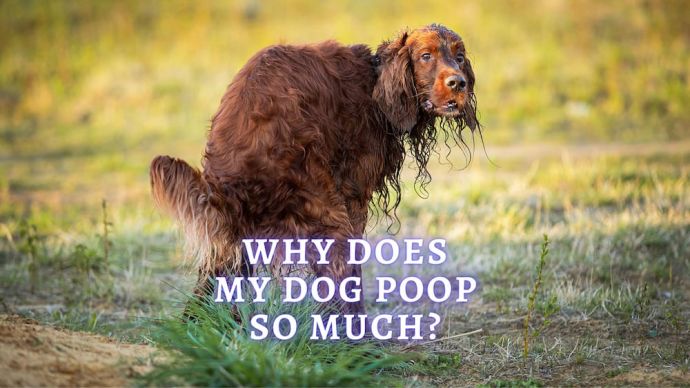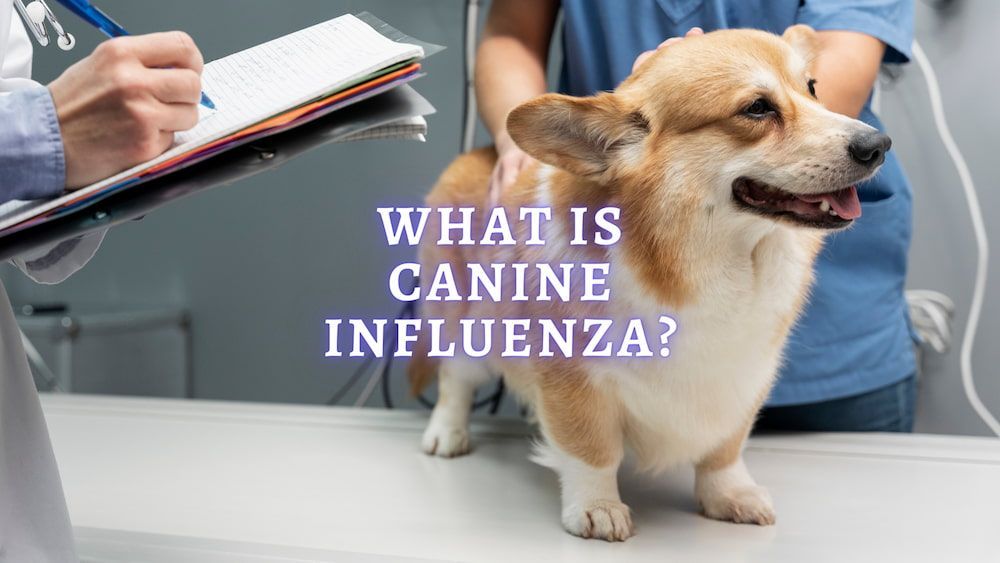Canine Influenza Symptoms, Treatment and Prevention
Written by:
Author: Marissa Prizio
Marissa Prizio attended the University of New Hampshire and earned a bachelor's degree in biomedical Animal Science. Marissa has always enjoyed writing; she was even mixing literature classes into her science major in college. During her writing career, she has edited eBooks, written for a variety of websites, and created audio-visual courses for sustainability.
View all 36 articlesLearn about our editorial process and veterinary review board.
Viewed: 59
Updated on: 01/17/2023
The illness tends to be a frightening experience for all pet parents. Even when you do your best to protect your pet, they can encounter invisible threats. Viruses can be difficult to detect before they infect a pet, but understanding the signs and how to help your pet heal can be very helpful.
The canine influenza virus, also known as dog flu, is a highly contagious and a rather recent threat to our canine companions’ health. [1] If you are trying to keep your dog healthy, this is a disease worth knowing about.
What is canine influenza?
Canine influenza virus refers to two specific influenza type A viruses, H3N8 and H3N2. Equines are the suspected species of origin for H3N8 and H3N2 may have had avian origins. [2] dog flu can be considered a relatively new strain of flu since both appeared in the United States within the past 18 years. [2] [3]These influenza viruses mutated to infect dogs, but there is currently no link between canine flu and human flu.
Canine influenza virus civ is a relatively new respiratory illness that shares many symptoms with kennel cough. Dog flu is highly contagious, and most dogs that encounter this illness end up with some level of infection. Luckily, the mortality rate of dog flu is very low in healthy animals. [4]
Since this illness is so contagious, dogs have no specific flu season. Infected individuals can transmit this flu to many other dogs at any given time, so outbreaks can occur year-round. [1] [2] [3]
What are the symptoms?
As with most flu cases, the canine influenza virus is known to affect the upper respiratory tract and result in a fever. Many of the symptoms associated with dog flu are shared with kennel cough, making it difficult to tell the two apart.
Signs of canine influenza include: [2]
- A fever
- A persistent cough (This coughing can be wet or dry)
- Eye discharge
- Sneezing
- A runny nose
- Reduced appetite
- Lethargy
Dog flu can appear in different intensities depending on the health, breed, age, and vaccination status of an individual. Not all infected animals would show symptoms of respiratory illness, but they can still produce respiratory secretions, making it easy for others to get infected. Approximately 20 to 25% of infected dogs show no signs of illness when infected. [2]
Pets infected with this respiratory disease tend to be most contagious and show very few to no symptoms during the first 2 to 4 days of infection. [2] Once your dog passes the incubation period and starts showing signs of illness, they may be less contagious but should still be kept away from other pets.
Dog flu may not be a severe illness, but it can lead to a more severe illness. This is especially true for dogs that are ill, elderly, or have difficulty breathing. In severe cases, dogs infected with canine flu can develop secondary bacterial infections or pneumonia, which can both be deadly. [2] [3]
The early onset of this disease is one of the best times to get your dog tested for canine influenza. If they receive a nasal swab within the first 4 days of symptoms, a PCR test can be submitted to determine the virus causing their infection. [4] The sooner you know their status, the better you can help protect almost all animals they would typically interact with.
RELATED: Dog Not Eating
How is this disease spread?
Dog flu spreads a lot like the human flu. Animals infected with the canine influenza virus are most contagious during the incubation period before they are symptomatic and pet owners realize something is wrong. During this time, most dogs interact with other dogs, spreading the virus through contact, airborne droplets, or vectors.
Coughing and sneezing certainly help spread the disease through airborne droplets, but they aren’t necessary to spread the dog flu. A quick sniff at dog parks, direct contact with contaminated objects, and even kennels can spread this highly contagious infection. [1]
Contaminated objects with hard surfaces can harbor this illness for up 48 hours, the fabric can carry dog flu for 24 hours, and human skin can carry influenza from an infected dog for 12 hours. [2] Dogs exposed to these surfaces can become sick if these vectors are not sanitized. This is why it is very important for kennel surfaces, veterinarians, and other high-traffic areas to sanitize regularly.
If your dog is showing signs of canine influenza, the best thing you can do is keep them isolated from other pets. [1] [2] [3] Communal water bowls and kennels are hot spots where this disease can thrive.
READ MORE: Is My Puppy Sick?
What is the treatment for canine influenza?
Like many other viruses, the canine influenza virus is best treated with supportive care. [1] [2] Unless your pet has preventative measures in place, like vaccination, there is no guaranteed way to stop this virus once it has taken hold. The good news is that dog flu has a rather low mortality rate for healthy infected dogs. [2] [3] Many of these dogs recover on their own with plenty of rest.
A majority of dogs make a full recovery within 2 to 3 weeks. [2] Although they are most contagious at the beginning of this period, isolation for exposed or ill dogs is recommended for four weeks. If your pet has lingering symptoms past this point, such as excessive nasal discharge and a continued lack of energy, a second vet visit may be warranted.
Infected dogs with other health conditions, difficulty breathing, and older pups are the most likely to require veterinary medicine. For these increased-risk pets, civ infection can turn into a severe illness that leads to secondary bacterial infections. [2] [3] To prevent the onset of pneumonia, clinical signs should be taken seriously.
Dog owners who notice compounding clinical signs should keep their dogs away from other dogs and seek the supportive care of a veterinarian immediately. For proper disease control, their pet may be isolated, but veterinary clinics are normally prepared for these cases. They will be best able to provide your pet with any fluids or medications needed to fight this illness.
Can I vaccinate my pet against canine influenza?
A CIV vaccine exists for the H3N8 and H3N2 strains of canine flu. [1] [2] [3] Like many other vaccines, this isn’t a guarantee against contracting this illness but it can at least help reduce the severity of symptoms. CIV vaccination is a great preventative measure, but it is not mandated the same way the rabies vaccine and distemper are.
The canine influenza vaccine is considered a lifestyle vaccine. [2] This means veterinarians only recommend it for pets with a higher chance of interacting with infected dogs. Even then, pet owners can turn down this vaccine or the veterinarian may be wary of giving it if the pet has a history of dog vaccine reactions.
If your dog spends time boarding in kennels or travels often, the vaccine may be required by specific establishments for entry. This is an effort to protect your pet’s health, as well as those around them. Not all dogs have the resources your pet does, so by opting for vaccination, you are protecting both your pet and those they socialize with.
Can people get dog flu?
There are many strains of influenza viruses, and some can jump between species. Varieties of the human flu have developed from other species in the past, and these can be dangerous since their novelty tends to make them difficult for our immune systems to combat.
The good news is that the influenza viruses afflicting pets have not caused any known illness in humans. [1] [2] [3] This goes both ways, with most variations of the human flu not causing infection in canines either. Your veterinarian can help you confirm that your pet has canine influenza so you can confidently provide care without concern regarding contact.
Our feline friends are not as fortunate. A few cases have been found where cats were infected with H3N2 transmitted by dogs. [2] [3] This variation of the infection could then spread through cat-to-cat transmission, producing similar symptoms to those in dogs.
What should I do if there is a Canine Influenza outbreak in my area?
If you receive notification from your veterinarian, groomer, or other sources that there is a CIV outbreak in your area you can take preventative measures to protect your pet. Start by limiting their socialization and monitoring them for symptoms.
If your pet is a high-risk individual with other underlying health conditions, check with your vet to see if vaccination would be a safe option. If your pet is otherwise young and healthy, you can request vaccination and discuss relevant information. This can be especially helpful if you can not avoid contact with other animals.
You may not be able to contract and transmit canine influenza, but you can carry it on your skin and clothes, so remember to sanitize yourself if you interact with other dogs. [1] [2] Even if the dogs you interact with seem to be healthy, it is always best to take precautionary measures, as they can be asymptomatic carriers of this virus.
Article Sources:
- “Key Facts about Canine Influenza (Dog Flu).” Centers for Disease Control and Prevention, 20 Nov. 2019, cdc.gov/flu/other/canine-flu/keyfacts.html.
- Ward, Ernest. “Canine Influenza: The Dog Flu.” VCA Animal Hospital, vcahospitals.com/know-your-pet/canine-influenza-the-dog-flu.
- “Canine Influenza: Pet Owners’ Guide.” American Veterinary Medical Association, avma.org/resources/pet-owners/petcare/canine-influenza-pet-owners-guide.
- “Canine Influenza Virus.” Cornell University College of Veterinary Medicine, vet.cornell.edu/animal-health-diagnostic-center/veterinary-support/disease-information/canine-influenza-virus.
 Dog Care White Specks In Dog Poop: What Are The Little White Specks In Dog Poop? (Vet Advice)
Dog Care White Specks In Dog Poop: What Are The Little White Specks In Dog Poop? (Vet Advice) - 659
- 0
 Dog Care Why Does My Dog Poop So Much? Determining A Healthy Poop Schedule For Your Dog
Dog Care Why Does My Dog Poop So Much? Determining A Healthy Poop Schedule For Your Dog - 184
- 0
 Dog Care When to Take Cone Off Dog After Neuter? Advice on Helping Your Dog to Recover
Dog Care When to Take Cone Off Dog After Neuter? Advice on Helping Your Dog to Recover - 306
- 0
 Dog Veterinary Tips Why is my Dog throwing up: Causes and Preventing (Veterinary Advice)
Dog Veterinary Tips Why is my Dog throwing up: Causes and Preventing (Veterinary Advice) - 23424
- 5
 Dog Care Why Is My Dog Bleeding From Its Butt? Causes and treatment of rectal bleeding in the dog
Dog Care Why Is My Dog Bleeding From Its Butt? Causes and treatment of rectal bleeding in the dog - 22076
- 0
 Dog Care My Dog Keeps Scratching His Mouth: Reasons Why Your Dog Scratching Face
Dog Care My Dog Keeps Scratching His Mouth: Reasons Why Your Dog Scratching Face - 17561
- 1























